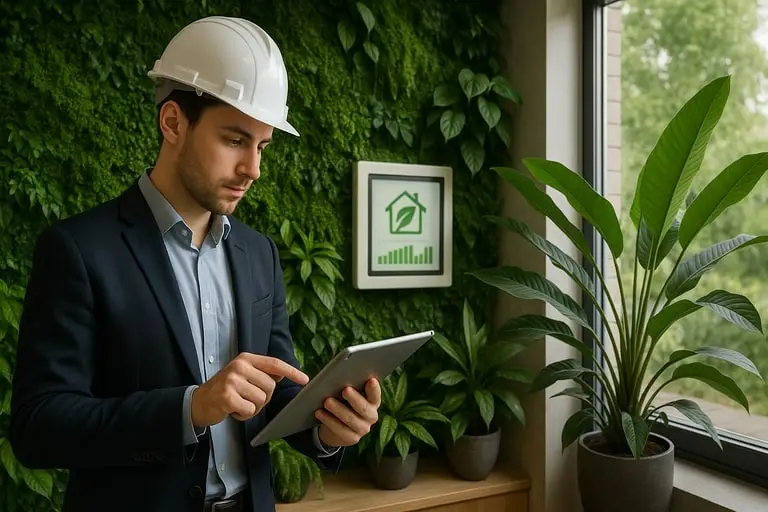Green building technology has emerged as the cornerstone of modern construction, weaving together sustainability, efficiency, and human wellbeing into one coherent framework that defines the future of the built environment. Unlike traditional methods, which often prioritize speed or cost at the expense of ecological balance, this new wave of innovation redefines how spaces are conceived, developed, and maintained. It integrates materials, design strategies, and engineering techniques to reduce environmental impact while enhancing durability and comfort. For industries, developers, and governments alike, the question is no longer whether to embrace sustainable solutions but how quickly they can implement them before falling behind in an increasingly competitive market where ecological responsibility is valued as much as economic gain.
The rise of green buildings reflects a paradigm shift from seeing structures as static entities to recognizing them as dynamic ecosystems. Every element—from insulation and energy systems to lighting and air circulation—contributes to a larger cycle of resource management. This holistic approach means that a building is not just a place for human activity but an active participant in reducing carbon footprints, conserving water, and minimizing waste. By using advanced building technologies, architects and engineers are reimagining what it means to live and work in spaces that align with both environmental preservation and modern human needs.
At the heart of sustainable design is the principle of efficiency without compromise. Materials such as recycled steel, engineered wood, or low-emission concrete are no longer viewed as secondary options but as central pillars in eco construction. These choices not only lower the burden on natural resources but also ensure long-lasting resilience. For example, advanced glazing systems reduce energy loss through windows while allowing natural light to permeate interiors, thereby cutting electricity demand without sacrificing aesthetics. The interplay of function and beauty defines this era of construction, setting a new standard where practicality does not mean blandness.
Developers are also exploring renewable energy systems embedded into buildings as a default rather than an optional feature. Solar panels integrated seamlessly into rooftops, geothermal heating systems that tap into the earth’s energy, and smart grids that balance supply and demand mark a new stage in construction innovation. Each system reduces dependence on fossil fuels while empowering communities to be self-sufficient in energy production. This trend aligns perfectly with the benefits of green building technology, which extend far beyond ecological gains to include financial stability, reduced operational costs, and enhanced property value.
Water management stands out as another defining characteristic of sustainable projects. Rainwater harvesting, greywater recycling, and efficient plumbing systems are reshaping how cities approach a resource once taken for granted. In regions where scarcity threatens daily life, green building solutions provide answers that combine practicality with resilience. Instead of extracting endlessly from strained reservoirs, modern systems encourage cyclical use, ensuring that water continues to flow where it is needed most. These advances remind us that true innovation is not about exploiting nature but about harmonizing with it.
The social dimension of eco construction is equally powerful. Occupants of environmentally conscious spaces consistently report improved health, productivity, and satisfaction. Indoor air quality is enhanced through low-toxin materials, efficient ventilation, and natural airflow systems that minimize pollutants. Acoustics, lighting, and thermal comfort all contribute to environments that support human performance without depleting the planet. These subtle but impactful design features illustrate how sustainability is not only about protecting nature but also about nurturing the people who inhabit these spaces every day.
Financial institutions and governments are also driving the adoption of green building technology by offering incentives, certifications, and tax benefits for projects that meet sustainability standards. Certifications such as LEED or BREEAM set benchmarks for developers, ensuring that claims of eco-friendliness are backed by measurable achievements. These standards foster trust among buyers and tenants while pushing the construction industry toward greater accountability. The alignment of public policy and private innovation creates a fertile ground for rapid growth, signaling a collective understanding that sustainability is no longer a luxury but a necessity.
Urban planning is another arena transformed by these advancements. Cities now envision integrated districts where transportation, housing, and workplaces are connected through energy-efficient systems, shared resources, and circular economies. Instead of isolated projects, entire neighborhoods are being designed to minimize emissions while maximizing community interaction. Green roofs, vertical gardens, and permeable pavements are becoming standard features, not decorative novelties. These choices redefine urban landscapes, transforming concrete jungles into living, breathing ecosystems that embody the essence of sustainable design.
Critics often argue that upfront costs pose barriers to adopting eco-friendly solutions, yet a closer look reveals the opposite. While initial investment may be higher, long-term savings in energy, water, and maintenance quickly offset the expense. Moreover, as technology advances and adoption scales, prices continue to drop, making sustainable solutions accessible to a wider audience. The economic argument for green building technology is as strong as the environmental one, proving that sustainability and profitability can coexist.
Perhaps the most compelling aspect of this transformation is its potential to reshape human values. As societies increasingly demand responsible construction, a cultural shift is occurring where buildings are judged not only by their appearance or price but by their ecological footprint and contribution to wellbeing. This change signifies a deeper understanding of humanity’s place within the natural world, moving beyond consumption toward stewardship. By redefining construction as a form of ecological partnership, green building technology fosters a legacy that extends far beyond the lifespan of any single project.
The future of construction, therefore, lies at the intersection of science, ethics, and design. Green building technology is not merely a trend but a framework that reimagines how humanity can thrive within planetary boundaries. By embracing sustainable design, adopting innovative building technologies, and recognizing the long-term benefits of eco construction, industries and societies can build spaces that are not only efficient and beautiful but also just and enduring. This holistic vision ensures that construction will continue to evolve as a driver of progress, resilience, and ecological harmony in a rapidly changing world.
Green Building Technologies Transforming Design
Green building technologies are transforming the way construction is approached, shifting the industry from traditional linear models toward integrated systems that emphasize sustainability, resilience, and adaptability. The concept extends beyond materials or energy efficiency and encompasses every layer of planning, engineering, and execution. This transition is a response to mounting global challenges: climate change, resource depletion, and urbanization pressures. By embracing technologies that support sustainable design and eco construction, the industry is redefining its responsibility to both people and the planet.
The application of smart building technologies is central to this transformation. Sensors, automation systems, and AI-driven platforms allow real-time monitoring of energy use, air quality, water consumption, and even occupant behavior. This digital integration ensures that structures operate at optimal levels without waste, making buildings not just passive spaces but active participants in conservation. Such advancements highlight the practical side of sustainable design, where innovation meets measurable impact.
Energy management remains one of the defining pillars of green building technologies. Photovoltaic glass, building-integrated wind turbines, and advanced storage systems allow buildings to produce and regulate their own power supply. These innovations reduce reliance on centralized grids and fossil fuels, fostering independence and resilience in the face of energy disruptions. By prioritizing renewable integration, eco construction strengthens communities and provides a scalable path toward carbon neutrality.
Water conservation is equally advanced under this framework. Smart irrigation, leak detection, and efficient reuse systems are transforming water cycles within urban landscapes. With populations rising and climates becoming less predictable, these innovations ensure that water resources are used responsibly. In cities where scarcity is critical, these measures form the backbone of long-term survival, demonstrating that sustainable design is about foresight as much as functionality.
Materials science plays an indispensable role in shaping the modern sustainable building. Innovations such as self-healing concrete, carbon-capturing bricks, and cross-laminated timber redefine durability while addressing ecological costs. Unlike conventional options that often degrade quickly and pollute in production, these alternatives embody a closed-loop mindset. They enhance structural resilience and minimize environmental impact, affirming the broader benefits of adopting advanced building technologies.
Indoor environmental quality also receives newfound attention through these solutions. Ventilation systems equipped with filters, air purifiers, and adaptive climate controls create healthier environments for occupants. Natural daylighting strategies supported by intelligent glass or reflective surfaces reduce dependency on artificial lighting while improving psychological wellbeing. The convergence of health and technology in eco construction proves that sustainability is not abstract but tangible in daily life.
Urban infrastructure integrates these technologies into collective ecosystems. Smart grids, waste-to-energy systems, and district heating networks align entire neighborhoods under principles of resource efficiency. Rather than isolated efforts, these models emphasize connectivity, demonstrating how green building technologies scale from individual projects to urban frameworks. The result is cities that not only expand responsibly but also thrive through collaboration with nature.
Economic implications strengthen the case for widespread adoption. Initial costs are increasingly offset by operational savings, higher property values, and tenant demand for sustainable spaces. Moreover, governments and institutions are aligning policies with sustainable goals, offering grants, subsidies, and certifications that reduce financial barriers. This synergy between public and private efforts ensures that eco construction is not just aspirational but achievable at scale.
Education and workforce development form another essential component. As new technologies emerge, professionals must adapt through training and certification. Universities and trade schools are revising curricula to include sustainable design principles, preparing the next generation of architects and engineers. This cultural shift ensures that sustainable construction is ingrained not as an exception but as the norm, capable of evolving continuously alongside technological progress.
Beyond the physical and financial dimensions lies the cultural transformation enabled by these innovations. As communities interact with green building technologies daily, sustainability becomes embedded in behavior and identity. People begin to value resource-conscious choices, influencing broader societal norms. In this way, construction technologies ripple outward, reinforcing ecological responsibility across industries and lifestyles.
Ultimately, the spread of green building technologies signifies a deep rethinking of how humanity inhabits the planet. By merging cutting-edge science with sustainable design principles, the construction sector is establishing a blueprint for a future where growth is harmonized with ecological limits. Each innovation represents not only technical progress but also a step toward redefining prosperity in terms of health, resilience, and shared responsibility.
Green Building Technology And Benefits Explained
The benefits of green building technology extend across environmental, economic, and social domains, reshaping the understanding of value in construction. Unlike conventional methods, which focus narrowly on short-term performance or cost, sustainable solutions highlight the long-term advantages that accrue to occupants, developers, and entire communities. This comprehensive perspective ensures that eco construction is recognized as both a moral imperative and a practical strategy for future development.
Environmental benefits remain the most immediate and visible. By lowering energy consumption, reducing emissions, and promoting circular resource use, buildings lessen their ecological footprint. Solar energy systems, rainwater harvesting, and sustainable materials collectively create spaces that work with nature rather than against it. These approaches mitigate climate change, conserve biodiversity, and ensure that urban expansion does not come at the expense of planetary health.
Economic advantages are equally compelling. Energy-efficient technologies translate into lower utility bills for occupants, while durable materials minimize repair and replacement costs. For developers, properties certified under sustainable standards command higher resale and rental values, appealing to environmentally conscious clients. The financial stability created by green building technology underscores that sustainability aligns with profitability, making it an attractive choice for investors and businesses.
Health and wellbeing form another powerful category of benefits. Occupants of sustainable buildings consistently report reduced stress, fewer respiratory issues, and greater satisfaction. Improved indoor air quality, optimized lighting, and thermal comfort directly enhance productivity and quality of life. These outcomes demonstrate that eco construction is not only about saving resources but also about creating nurturing spaces that improve human potential.
Community benefits also emerge from the widespread adoption of these practices. Eco-conscious developments reduce strain on municipal utilities by conserving water and lowering peak energy demand. They also create public spaces that encourage interaction, mobility, and inclusion, reinforcing social cohesion. In this sense, the benefits of green building technology extend beyond individual structures to entire neighborhoods and cities.
Policy frameworks amplify these advantages by embedding them in governance systems. Tax incentives, subsidies, and recognition programs make sustainability more attractive for developers and owners. This alignment ensures that private motivations converge with public goals, accelerating adoption. As more jurisdictions embrace mandatory standards, sustainable construction is transitioning from a choice to a requirement, reinforcing the systemic nature of its benefits.
Technological progress continually enhances the scope of these advantages. As materials evolve and monitoring systems become more sophisticated, the efficiency gap between conventional and green buildings widens. This technological acceleration ensures that adopting eco construction is not a static choice but a pathway of continuous improvement. Stakeholders who invest in sustainable design are rewarded with assets that remain competitive over decades.
Education and awareness also magnify the benefits by influencing consumer expectations. As people become more informed about ecological challenges and health impacts, demand for sustainable spaces grows. Developers and businesses that respond proactively secure reputational advantages, positioning themselves as leaders in innovation and responsibility. The cultural shift generated by this awareness underscores that sustainability is not just a technical solution but a societal movement.
Global connectivity further reinforces these benefits. Knowledge exchange between countries and industries accelerates adoption, allowing best practices to spread rapidly. International certifications and standards create common benchmarks, enabling collaboration across borders. This global approach ensures that the benefits of green building technology are not confined to isolated regions but contribute to a collective effort against environmental crises.
The resilience benefits of eco construction also stand out in a world facing increasing uncertainty. Sustainable buildings are designed to withstand extreme weather, resource volatility, and economic disruption. Their adaptability ensures continuity of operations and protection for occupants during crises. This resilience highlights the forward-looking nature of sustainable design, offering security as well as efficiency.
Ultimately, the benefits of green building technology lie in its ability to align ecological stewardship with human progress. It offers a pathway where environmental care, financial gain, and social wellbeing coexist. By integrating sustainable design, innovative building technologies, and eco construction practices, societies can ensure that future growth remains balanced and inclusive. The vision extends beyond saving resources; it represents a holistic redefinition of prosperity that places life quality, resilience, and responsibility at its center.
The twenty-first century has seen a dramatic shift in how societies envision the built environment. Traditional methods focused largely on durability and cost, but the global urgency of climate change has redirected attention toward sustainability. This is where eco construction stands as the defining philosophy of modern building practices. It is not simply a trend but a comprehensive framework that prioritizes efficiency, reduces carbon footprints, and harmonizes human development with ecological balance. From the raw materials used to the energy performance of finished structures, every element reflects a conscious choice to build responsibly, leaving behind legacies of health, comfort, and resilience rather than pollution and waste.
The essence of eco construction lies in combining innovative technology with time-tested natural solutions. Architects and engineers integrate solar panels, green roofs, and rainwater harvesting systems into urban projects while also embracing clay, timber, and stone that have sustained civilizations for millennia. The result is an architecture that reduces reliance on nonrenewable energy, minimizes waste streams, and ensures that indoor environments remain safe and comfortable. Unlike conventional methods that often separate construction from the environment, eco-oriented practices treat the building as an active participant in its ecosystem, ensuring that every design decision strengthens the relationship between people and nature.
Cities across the globe are rapidly adapting eco construction principles to address growing concerns about pollution, resource scarcity, and the costs of climate-related disasters. Urban areas adopt smart grids, energy-efficient transportation hubs, and high-performance buildings designed to remain resilient even under extreme weather. Governments increasingly mandate green building certifications and integrate eco-friendly planning into zoning laws. As sustainability becomes both a necessity and a competitive advantage, developers recognize that projects aligned with ecological responsibility attract higher valuations, investor confidence, and long-term community support. The city of the future is no longer defined solely by glass and steel but by symbiosis with the planet’s natural systems.
A defining feature of eco construction is its reliance on renewable resources and closed-loop systems. Recycled steel, bamboo, hempcrete, and reclaimed wood are replacing energy-intensive concrete and plastics. Construction waste, once discarded, is now transformed into new inputs for flooring, insulation, or decorative finishes. Water cycles are optimized through low-flow plumbing and greywater reuse, while energy cycles incorporate geothermal systems and passive solar design. These approaches prove that sustainability does not mean sacrificing performance; on the contrary, buildings created through such practices often outperform traditional structures in durability, comfort, and efficiency. Each innovation demonstrates how ecological responsibility can be embedded without compromising functionality or aesthetics.
The environmental benefits of eco construction extend far beyond individual buildings. When scaled across neighborhoods and regions, green practices reduce urban heat islands, improve air quality, and increase biodiversity through green corridors and rooftop gardens. Renewable energy integration reduces dependence on fossil fuels, cutting carbon emissions at the community level. Social benefits follow: healthier residents, lower utility costs, and reduced strain on public infrastructure. The ripple effect ensures that every eco-oriented project contributes not only to the occupants but also to the broader society, proving that sustainable construction is both a private investment and a public good.
Economic arguments reinforce the adoption of eco construction. While green buildings sometimes carry higher upfront costs, long-term operational savings outweigh the initial investment. Energy bills are drastically reduced, maintenance costs decline thanks to durable materials, and resale values increase as sustainability becomes a standard market expectation. Financial institutions and insurers increasingly favor green projects, recognizing their resilience to risks such as fire, flooding, and energy price volatility. Developers who prioritize ecological principles therefore enjoy both reputational advantages and financial incentives, making eco-friendly construction a win-win model that aligns environmental duty with economic gain.
The technologies driving eco construction continue to evolve at breathtaking speed. Innovations in 3D printing now allow entire homes to be created using biodegradable or recycled materials. Smart sensors monitor air quality, energy use, and occupancy patterns, enabling real-time adjustments that improve efficiency. Advanced glazing adapts automatically to changing sunlight, while living walls purify indoor air and contribute to natural insulation. As digital tools integrate with ecological design, buildings transform into intelligent ecosystems, capable of adapting dynamically to their environment. This synergy between technology and nature represents the cutting edge of modern architecture, where sustainability becomes not only a design principle but a lived reality.
Policy frameworks and certifications amplify the role of eco construction. Programs such as LEED, BREEAM, and national green building standards set benchmarks for energy performance, water conservation, and material sustainability. Governments worldwide are incentivizing developers with tax credits, grants, and expedited permits for projects that meet these standards. Municipalities embed ecological priorities into urban planning, ensuring that transport, waste management, and residential zones all contribute to environmental harmony. These frameworks are crucial in transforming individual initiatives into global movements, ensuring that eco-friendly construction becomes the rule rather than the exception.
Looking ahead, the trajectory of eco construction is poised to reshape civilization itself. As populations expand and cities grow, the demand for sustainable infrastructure will only intensify. Future innovations will likely merge biotechnology with architecture, creating buildings that grow, self-heal, and actively absorb carbon. Communities will be designed as regenerative systems, producing more energy and clean water than they consume. Ultimately, eco-conscious construction is not a niche practice but humanity’s blueprint for survival, ensuring that future generations inherit cities and homes that nurture life rather than threaten it. In this way, eco-friendly construction secures a lasting legacy of resilience, prosperity, and balance between people and the planet.













